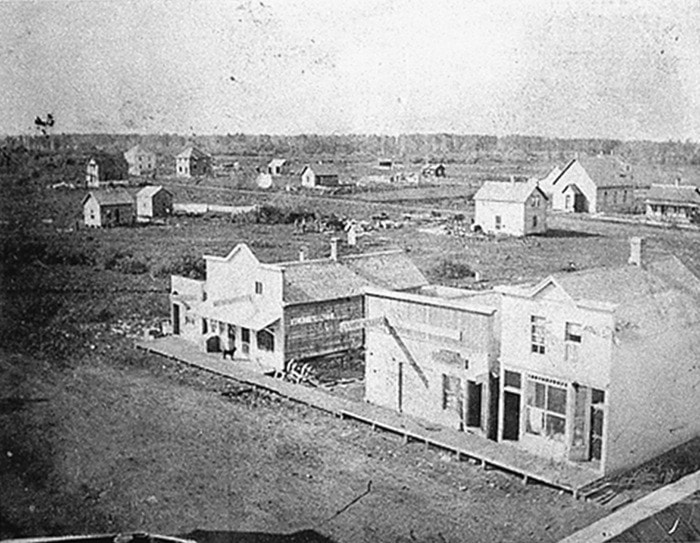The real story of the long and colourful trail of progress, hardships and successes for the tiny Village of Ponoka located next to the usually placid Battle River likely really began with the arrival of the Canadian Pacific Railroad line on July 2, 1891 at a point known simply as ‘Siding No. 14.’
By that time this rugged expanse of wilderness in the heart of Alberta had seen the exciting travels and brave exploits of famous explorers, missionaries, colourful and proud Indian tribes, patient fur traders and the first influx of hardy pioneer families who were looking to establish a new beginning in a free and fertile land.
The next major milestone going into the future for this thriving little community and surrounding districts was the incorporation of the Town of Ponoka in 1904. Mr. John MacGillivaray (who later lived to the ripe old age of 102) was named as the first mayor, while C.C. Reid served as the secretary treasurer for the first six years, and was then replaced by John A. Jackson. In those humble beginnings the entire town staff included the combined single position of handyman and policeman, the first being Jack Few, followed by John Schnoor, who faithfully served the job for many years until being seriously injured in a Halloween prank.
As town councils were elected by the growing onslaught of new citizens they went about their increasing slate of business, and were led into the bright future by secretary treasurers that included J.W. Hutchison, L.B. Courtright and J.M. Sparks. Mr. W.R. Ferguson accepted the position in 1921 and served until 1937 when Mr. Jake H. Galbraith came on board and helped to establish an excellent and ongoing rapport with the expanding community until his retirement in 1961 when he was replaced by Mr. Don L. Saunders. The monthly payroll for the Town of Ponoka was $500.00 in 1937, but over the years as the community grew and flourished the mid-1980s staff included 24 regular employees with a monthly payroll of $16,000.00.
Going back to a few exciting community highlights from back at the beginning: Ponoka’s first telephone pole to be installed in the Bell Telephone Calgary to Edmonton line was set up across the street from the now historical Royal Hotel in 1903. Crews then became very busy constructing the lines both north and south from Ponoka, and the town’s first telephone exchange was situated in Campbell’s Drug Store on Chipman Avenue, and was operated by Lily Goodman (Sayers), who doubled as both telephone operator and clerk on the busy and constantly buzzing new circuit. Jumping ahead through the roaring ’20s and the arrival of motor-mania the Town welcomed many newcomers and businesses and would double in population from 473 in 1906 to 836 in 1931. Things would slow down a little through the devastating ’30s and into the war years, but everyone worked hard together to survive, the town and county began to boom, and the largest ever increase in the population of our thriving community came occurred between 1946 to 1951 when it exploded from 1,468 to 3,574, reached 5,473 in 1986, and just kept on growing and going.
The gas was piped into town in 1946 and the official ‘turn on’ was celebrated with the lighting of a flare in a vacant lot next to McKelvey’s Garage on 50th Street in October. In 1947 the first modern Ponoka General Hospital was opened, and then in 1948 the town’s water and sewer installation were completed and was marked by a huge public bonfire conducted by the local fire brigade next to the CPR station, where all the old local outdoor wooden biffies were burned. With the steady advent of modern amenities and strong growth the town welcomed Federal Government funds in 1950 and supplied the land and the ground work to prepare for the construction of 25 homes in the Lucas Heights area for low rental to married war veterans. In 1953 an extensive program of concrete, sidewalk, curb, and gutter was undertaken, and by the 1980s Ponoka had been blessed with 25 miles of paved streets, 10 miles of gravelled streets, nine miles of storm sewers, and 22 miles of water main and sanitary sewers.
From 1912 until 1929 the electric energy for the town was supplied by the power plant at the Alberta Hospital after which the power was bought from Calgary Power under contract. Total debenture debt of the Town of Ponoka going into the 1980s was approximately $1,200,000 with an assessment of around $9,000,000, but the value of the town’s public utilities, the water works, and the electric light system were greatly in excess of the debenture debt, which resulted in the fact that the financial affairs of the town were in excellent shape.
Along the way over those challenging but colourful and exciting 113 plus years, The Town of Ponoka has and always will be indebted and appreciative to all of those who have served as councillors, mayors, managers and board members. Through these dedicated efforts and those of the town staff and many thousands of citizens, our community has thrived and will always remain a great place to live, work and to raise a family. As we follow our proud history and our countless successes we should always remember and salute all the pioneers of Ponoka and districts, who together have endured the many hardships and challenges, but prevailed with keen spirit and provided the solid foundations that have resulted in the many comforts and the promising future that we enjoy today.
